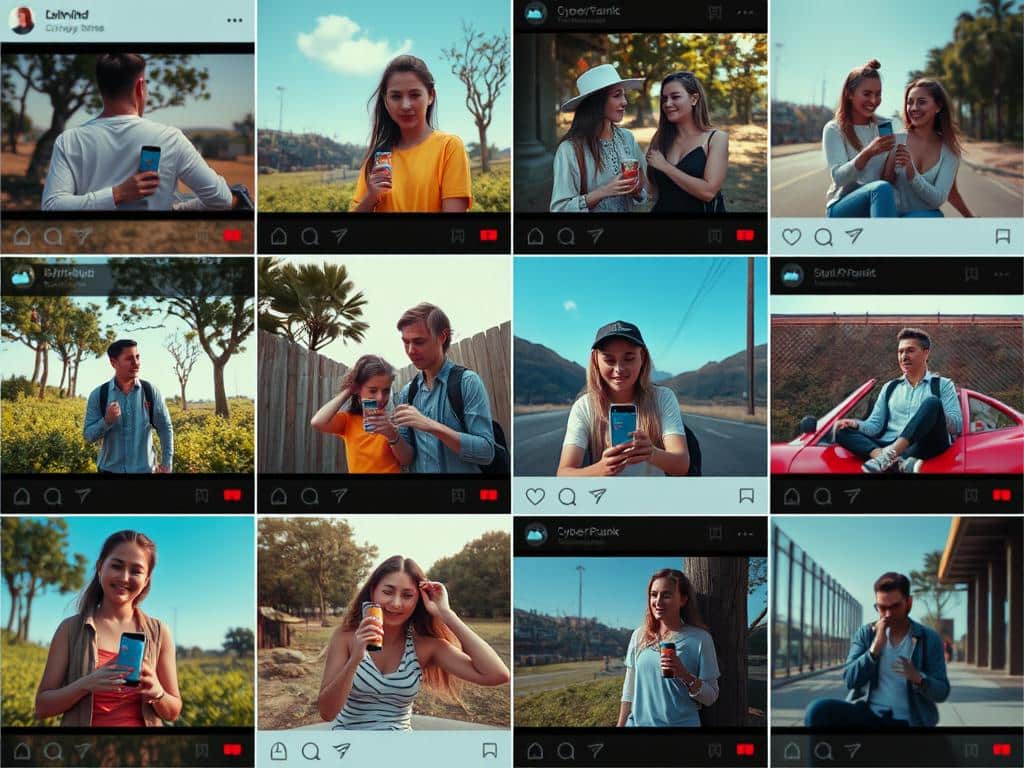Online video advertising is a powerful and effective strategy utilized in video marketing to advertise products and services. With global video ad expenditures projected to exceed $190 billion by 2024, video advertisements have become a mainstream solution for reaching a vast audience. This promotional content can seamlessly integrate into various streaming content, appearing before, during, or after video playback, such as the pre-roll or mid-roll ads seen on YouTube.
From social media platforms to mobile applications and native video ads, the scope of video ad formats is expansive. Engagement with video content is significantly notable; as revealed by recent statistics, about 91% of consumers express a strong desire to see more video content from brands. Marketers are leveraging this trend, with 92% reporting satisfactory returns on investment (ROI) from their video ad activities. Despite these successes, 39% of marketers highlight increasing costs in video marketing endeavors.
The rise in mobile video marketing is another critical dimension of this evolution. As mobile becomes the preferred viewing platform, with 75% of consumers favoring short-form video on mobile devices, the future of online video advertising is geared towards greater mobile integration. This dynamic and continuous evolution of video marketing underscores its significance as a cornerstone of modern advertising strategies.
The Rise of Online Video Advertising
The journey of online video advertising has been marked by significant milestones, showcasing its unprecedented video ad growth. From the broadcast of the first-ever video commercial in 1941 on television to the golden age in the 1950s and 1960s, video has always played a crucial role in marketing. Today, the video marketing evolution continues as advertisers adapt to changing media consumption habits and technological advancements.
History and Evolution
Initially, TV commercials dominated the advertising landscape, but with the arrival of the internet and platforms like YouTube, the dynamics began to shift. YouTube introduced various ad formats, including skippable and non-skippable ads, which paved the way for a new kind of video advertising. In 2007, Apple’s iPhone revolutionized mobile video consumption, making it a mainstream activity.
By 2013, social media giants such as Twitter, Facebook, Snapchat, and Instagram began incorporating video-sharing features, making video ads ubiquitous across platforms. Storyly enabled video ad stories in mobile apps, further diversifying the landscape. This period marked a significant phase in the video marketing evolution, empowering advertisers with new tools to reach their audience.
Current Trends
Video advertising trends today highlight the popularity of short-form content, driven by platforms like TikTok and YouTube Shorts. Consumers’ preference for mobile-first video content is evident, with 75% of viewers opting to watch short videos on their devices. The proliferation of affordable online video creation tools and the rise of AI-powered generative tools, such as OpenAI’s Saro, have democratized video production, making it accessible to brands of all sizes.
Additionally, video ads offer enhanced targeting capabilities, using data to reach specific demographics, interests, and behaviors. This personalized approach boosts engagement and conversion rates, cementing video ads as an indispensable tool in marketing strategies.
Future Projections
Looking ahead, the future of video marketing appears promising. By the end of 2024, video content is expected to account for 82% of all internet traffic. Mobile video ads will continue to dominate as technological advancements introduce innovative ad formats and improve video production quality. AI and machine learning will further personalize video content, fostering deeper connections with audiences.
The future of video marketing will also see brands capitalizing on the emotional connectivity of video ads. The use of faces, music, and sound effects in video content helps establish a strong emotional bond with viewers, increasing brand recall and loyalty. As video advertising evolves, it will remain at the forefront of digital marketing strategies, driving engagement and delivering compelling narratives.
Understanding Video Ad Formats
The diverse landscape of video ad formats caters to various marketing strategies and audience preferences. As digital video advertising evolves, understanding and utilizing the right video formats can significantly impact your campaign’s success.
In-stream Ads
Instream video ads are the most familiar format, often displayed within a video streaming platform like YouTube. These ads come in skippable and non-skippable varieties and can be highly interactive, encouraging viewer participation. For example, skippable instream ads reported high engagement rates and click-through rates, especially in campaigns focusing on sales, leads, website traffic, awareness, and consideration. With linear and nonlinear options, brands can strategically place ads pre-roll, mid-roll, or post-roll to capture audience attention effectively.
Outstream Ads
Outstream video advertising offers a unique approach by placing ads outside of video streams. These ads appear within articles or as overlays and require viewers to engage actively before they can proceed. Outstream ads are tailored to attract attention in non-video environments, enhancing viewer interaction and engagement. This format is particularly effective for reaching audiences on mobile devices and in-feed contexts, leveraging the growing demand for video content within social media feeds.
Bumper Ads
Bumper video formats, restricted to six seconds or less, are designed for brevity and impact. They are non-skippable, ensuring the complete delivery of your message. Despite their short duration, bumper ads are great for brand reminders and promotions. Platforms like YouTube report higher conversion rates with such compact messaging, making them ideal for reinforcing brand awareness and driving quick, memorable interactions.
Native Ads
Native video content blends seamlessly with the hosting platform, enhancing the overall user experience. These ads are less intrusive and more engaging, often delivering content that feels part of the natural flow. By matching the platform’s style and format, native ads increase the likelihood of user interaction and can significantly boost engagement rates. They also offer advantages in opt-in viewing, with methods like Click-to-Watch giving users control over their viewing experience, which is highly valued by audiences.

To compare some key aspects of these ad formats, consider the following details:
| Ad Format | View Reporting | Length Recommendation | Public View Count | Remarketing Capability | Campaign Types |
|---|---|---|---|---|---|
| Skippable In-stream Ads | Yes | No max length, <3 min recommended | Yes (videos less than 10 seconds will not) | Yes | Video action campaigns, Video view campaigns, Video reach campaigns |
| In-feed Video Ads | Yes | No max length | Yes | Yes | Video action campaigns, Video view campaigns, Video reach campaigns |
| Non-skippable In-stream Ads | No | 15 seconds | No | No | Video reach campaigns |
| Bumper Ads | No | 6 seconds | No | No | Video reach campaigns |
| YouTube Shorts Ads | Yes | <60 seconds recommended | Yes | No | Video action campaigns, Video view campaigns, Video reach campaigns |
By understanding these video ad formats, you can better strategize and optimize your digital video advertising efforts, ensuring higher engagement and conversions.
Benefits of Online Video Advertising
Online video advertising offers several compelling benefits to marketers aiming to make an impact in the digital realm.
High Engagement Rates
The power of effective video marketing lies in its ability to captivate audiences through rich visual and auditory stimuli. This high level of engagement results in phenomenal brand recall and recognition. For instance, YouTube viewers watch an astounding 1 billion hours of video content daily, proving the platform’s extensive reach and influence. Additionally, 76% of marketing videos are hosted and shared on social media, highlighting the video’s virality factor. Tweets with video content tend to generate 10 times more engagement than text-only tweets.
Increased Conversion Rates
The capacity for video ad engagement to translate attention into action cannot be overstated. According to recent statistics, 84% of people say they bought a product or service after watching a brand’s video. Moreover, studies reveal that long video ads offer 50% more conversions than shorter ones. This kind of conversion through video ads demonstrates the substantial return on investment (ROI) that marketers experience with a thoughtful video strategy. With millennials and Gen Zers being highly active on platforms like Facebook, Instagram, and TikTok, the potential for action-driven responses is immense.
Emotional Connectivity
One of the most potent aspects of video advertising is its ability to create an emotional impact in video advertising. Compelling stories and engaging content foster deep emotional connections between the brand and the audience. Campaigns like Dove’s “Real Beauty Sketches” and Notion’s dynamic ads exemplify this emotional resonance, which not only drives brand visibility but also enhances consumer relationships. Videos are 51% more likely to be shared than other content types, thus amplifying their reach and effectiveness. In comparison with other advertising formats, online video ads provide a targeted approach that effectively engages audiences on various social media platforms.
Challenges in Online Video Advertising
While online video advertising offers numerous benefits, it is not without its challenges. One of the significant obstacles in video marketing includes high production costs. Quality video ad production can be pricey, which poses a considerable hurdle, especially for smaller businesses with limited budgets.

Viewer fatigue and banner blindness are growing concerns. As audiences are flooded with video content, engagement and click-through rates tend to diminish. This leads to video ad challenges where capturing and maintaining viewer attention becomes increasingly difficult.
Another notable difficulty in disrupting video advertising is achieving the delicate balance between engaging content and disruptive advertising. Advertisements perceived as intrusive or irrelevant can lead to negative viewer reactions. Marketers must ensure that their ads provide real value rather than just being a nuisance.
The rapid evolution of online video platforms introduces additional video marketing difficulties. Marketers need to continuously adapt to new trends, consumer preferences, and technological advancements. This adaptability is essential to stay relevant and effective in a constantly shifting landscape.
Ensuring that ad content is optimized for a variety of devices and platforms, particularly mobile, adds complexity. With smartphones being the primary means for customers to reach brand content, creating mobile-friendly video ads is crucial. Data shows that US$193.4 billion is forecasted for mobile video advertising by 2028, underlining the importance of mobile optimization.
Understanding and effectively using diverse Key Performance Indicators (KPIs) is another challenge. Impressions are currently the preferred KPI, but traditional metrics like click-through rates often fall short in measuring video advertising effectiveness. This necessitates new methods of data evaluation.
Collaborations with major TV manufacturers and telecommunication providers to build a “Connected TV” data system could be a way forward. Entrepreneurs must leverage these partnerships to overcome the obstacles in video marketing and maximize the benefits of video ad campaigns. Addressing these video marketing difficulties is essential for creating meaningful connections with your audience.
Key Strategies for Effective Online Video Advertising
Crafting an effective online video advertising strategy requires a blend of creativity and analytics-driven decision-making. To capture viewers’ attention within the first few crucial seconds, content must be compelling, with a clear hook or engaging narrative that entices continued watching.
Creating Attention-Grabbing Content
The essence of compelling video content lies in its ability to immediately draw in the viewer. With 83% of video marketers stating that video helps them generate leads, creating content that captivates from the start is paramount. Utilize storytelling, high-quality visuals, and dynamic elements to hold attention and drive engagement.
Optimizing for Mobile
With 77% of individuals surveyed using a smartphone or tablet to watch online videos, mobile video optimization is essential. This involves configuring video content with a mobile-first mindset, taking into consideration screen sizes, loading speeds, and data limitations. Mobile-friendly layouts and vertical video formats can enhance the viewing experience and reach more users.
Utilizing Analytics
Leveraging video analytics for marketing enables the refinement of strategies through data-driven insights. Tracking key performance indicators (KPIs) such as view count, engagement rate, and social shares allow marketers to measure the success and impact of their campaigns. This approach ensures that the content not only reaches the audience but also resonates effectively with them.
Choosing the Right Platforms
Finally, video ad platform selection plays a vital role in the overall success of an online video advertising strategy. Each platform offers unique advantages: YouTube provides extensive reach, Facebook and Instagram enable detailed targeting, and platforms like Outbrain specialize in native video advertising. By aligning campaign objectives with the specific strengths of each platform, marketers can maximize their efforts and achieve better results.
How Does a Media Kit Support Online Video Advertising?
A media kit serves as a strategic tool in online video advertising, offering essential data like audience statistics, pricing, and ad formats. For those asking “what is a media kit in advertising,” it’s a comprehensive guide that helps advertisers craft effective campaigns by aligning content with the audience’s preferences and platform capabilities.
Conclusion
As we conclude this comprehensive summary of online video advertising, it is evident that this medium has carved a significant niche in modern marketing strategies. With a remarkable 91% of businesses leveraging video as a powerful marketing tool and a staggering 96% of marketers affirming its importance, video marketing insights reveal an unyielding trend toward this engaging form of content. Today, 91% of consumers express a burgeoning interest in seeing more online video content from brands, emphasizing the essential role videos play in audience engagement and emotional connectivity.
Our recap of video ad benefits highlights the multifaceted advantages that online video advertising brings to the table. Videos not only offer higher click-through rates compared to traditional text or image-based ads but also significantly boost purchase intent, with over 60% of consumers more likely to buy after watching a branded social media video. Furthermore, the ability to deploy various advertising techniques—such as pre-roll and mid-roll ads, banners, pop-ups, product placement, branded content, and sponsored recommendations—allows businesses to target their audience effectively, enhancing the chances of their ads being viewed and acted upon.
Looking ahead, future video ad strategies will necessitate a keen focus on leveraging analytics, optimizing for mobile, and crafting attention-grabbing content tailored to specific platforms. As streaming services continue to dominate, understanding the diverse formats and innovative approaches in online video advertising becomes crucial. Ultimately, by embracing innovation and prioritizing a seamless audience experience, marketers can harness the full potential of online video advertising to achieve higher engagement and conversions, thereby ensuring success in this dynamic digital landscape.








